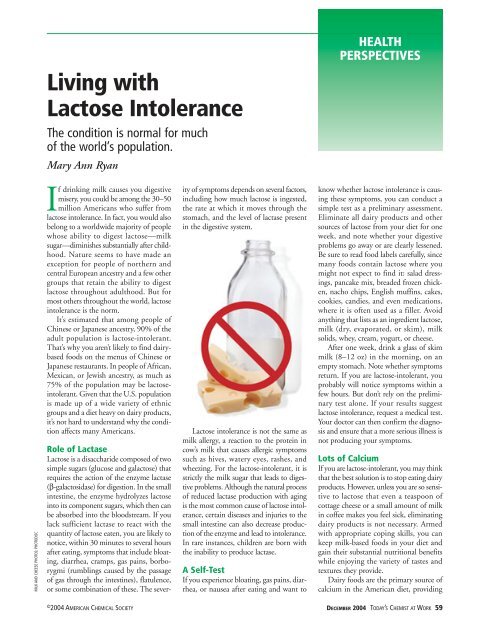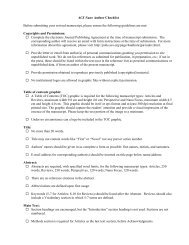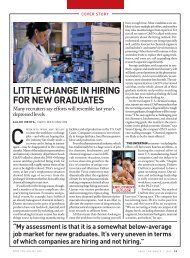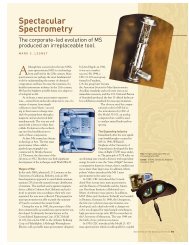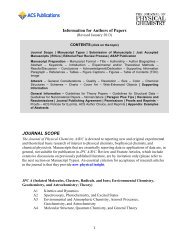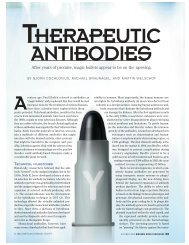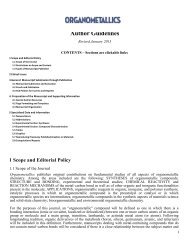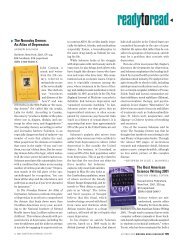Living with Lactose Intolerance - American Chemical Society ...
Living with Lactose Intolerance - American Chemical Society ...
Living with Lactose Intolerance - American Chemical Society ...
You also want an ePaper? Increase the reach of your titles
YUMPU automatically turns print PDFs into web optimized ePapers that Google loves.
MILK AND CHEESE PHOTOS: PHOTODISC<br />
<strong>Living</strong> <strong>with</strong><br />
<strong>Lactose</strong> <strong>Intolerance</strong><br />
The condition is normal for much<br />
of the world’s population.<br />
Mary Ann Ryan<br />
If drinking milk causes you digestive<br />
misery, you could be among the 30–50<br />
million <strong>American</strong>s who suffer from<br />
lactose intolerance. In fact, you would also<br />
belong to a worldwide majority of people<br />
whose ability to digest lactose—milk<br />
sugar—diminishes substantially after childhood.<br />
Nature seems to have made an<br />
exception for people of northern and<br />
central European ancestry and a few other<br />
groups that retain the ability to digest<br />
lactose throughout adulthood. But for<br />
most others throughout the world, lactose<br />
intolerance is the norm.<br />
It’s estimated that among people of<br />
Chinese or Japanese ancestry, 90% of the<br />
adult population is lactose-intolerant.<br />
That’s why you aren’t likely to find dairybased<br />
foods on the menus of Chinese or<br />
Japanese restaurants. In people of African,<br />
Mexican, or Jewish ancestry, as much as<br />
75% of the population may be lactoseintolerant.<br />
Given that the U.S. population<br />
is made up of a wide variety of ethnic<br />
groups and a diet heavy on dairy products,<br />
it’s not hard to understand why the condition<br />
affects many <strong>American</strong>s.<br />
Role of Lactase<br />
<strong>Lactose</strong> is a disaccharide composed of two<br />
simple sugars (glucose and galactose) that<br />
requires the action of the enzyme lactase<br />
(β-galactosidase) for digestion. In the small<br />
intestine, the enzyme hydrolyzes lactose<br />
into its component sugars, which then can<br />
be absorbed into the bloodstream. If you<br />
lack sufficient lactase to react <strong>with</strong> the<br />
quantity of lactose eaten, you are likely to<br />
notice, <strong>with</strong>in 30 minutes to several hours<br />
after eating, symptoms that include bloating,<br />
diarrhea, cramps, gas pains, borborygmi<br />
(rumblings caused by the passage<br />
of gas through the intestines), flatulence,<br />
or some combination of these. The sever-<br />
© 2004 AMERICAN CHEMICAL SOCIETY<br />
ity of symptoms depends on several factors,<br />
including how much lactose is ingested,<br />
the rate at which it moves through the<br />
stomach, and the level of lactase present<br />
in the digestive system.<br />
<strong>Lactose</strong> intolerance is not the same as<br />
milk allergy, a reaction to the protein in<br />
cow’s milk that causes allergic symptoms<br />
such as hives, watery eyes, rashes, and<br />
wheezing. For the lactose-intolerant, it is<br />
strictly the milk sugar that leads to digestive<br />
problems. Although the natural process<br />
of reduced lactase production <strong>with</strong> aging<br />
is the most common cause of lactose intolerance,<br />
certain diseases and injuries to the<br />
small intestine can also decrease production<br />
of the enzyme and lead to intolerance.<br />
In rare instances, children are born <strong>with</strong><br />
the inability to produce lactase.<br />
A Self-Test<br />
If you experience bloating, gas pains, diarrhea,<br />
or nausea after eating and want to<br />
HEALTH<br />
PERSPECTIVES<br />
know whether lactose intolerance is causing<br />
these symptoms, you can conduct a<br />
simple test as a preliminary assessment.<br />
Eliminate all dairy products and other<br />
sources of lactose from your diet for one<br />
week, and note whether your digestive<br />
problems go away or are clearly lessened.<br />
Be sure to read food labels carefully, since<br />
many foods contain lactose where you<br />
might not expect to find it: salad dressings,<br />
pancake mix, breaded frozen chicken,<br />
nacho chips, English muffins, cakes,<br />
cookies, candies, and even medications,<br />
where it is often used as a filler. Avoid<br />
anything that lists as an ingredient lactose,<br />
milk (dry, evaporated, or skim), milk<br />
solids, whey, cream, yogurt, or cheese.<br />
After one week, drink a glass of skim<br />
milk (8–12 oz) in the morning, on an<br />
empty stomach. Note whether symptoms<br />
return. If you are lactose-intolerant, you<br />
probably will notice symptoms <strong>with</strong>in a<br />
few hours. But don’t rely on the preliminary<br />
test alone. If your results suggest<br />
lactose intolerance, request a medical test.<br />
Your doctor can then confirm the diagnosis<br />
and ensure that a more serious illness is<br />
not producing your symptoms.<br />
Lots of Calcium<br />
If you are lactose-intolerant, you may think<br />
that the best solution is to stop eating dairy<br />
products. However, unless you are so sensitive<br />
to lactose that even a teaspoon of<br />
cottage cheese or a small amount of milk<br />
in coffee makes you feel sick, eliminating<br />
dairy products is not necessary. Armed<br />
<strong>with</strong> appropriate coping skills, you can<br />
keep milk-based foods in your diet and<br />
gain their substantial nutritional benefits<br />
while enjoying the variety of tastes and<br />
textures they provide.<br />
Dairy foods are the primary source of<br />
calcium in the <strong>American</strong> diet, providing<br />
DECEMBER 2004 TODAY’S CHEMIST AT WORK 59
HEALTH PERSPECTIVES<br />
Table 1. Calcium Content<br />
of Dairy Foods<br />
Quantity, Calcium, mg<br />
Food oz (approx)<br />
Cheddar cheese<br />
Ice cream, vanilla<br />
1 204<br />
Hard 8 168<br />
Soft 8 226<br />
Milk (fluid), 1% fat 8 290<br />
Yogurt, plain (nonfat) 8 452<br />
Source: U.S. Department of Agriculture, National Nutrient<br />
Database for Standard Reference, Release 17.<br />
75% of the calcium intake (see Table 1).<br />
Calcium is particularly important in the<br />
prevention of osteoporosis. The Institute<br />
of Medicine at the National Academy of<br />
Sciences recommends a minimum of 1000<br />
mg of calcium per day for most adults and<br />
1200 mg for those over 50 years old. Typical<br />
servings of most foods, unless they are<br />
fortified <strong>with</strong> calcium, do not come close<br />
to the calcium content of dairy products<br />
(1). Although calcium supplements can<br />
be beneficial, they should be viewed as<br />
adjuncts to food-derived calcium, not as<br />
total replacements.<br />
How To Avoid Discomfort<br />
If you are lactose-intolerant, you need<br />
guerrilla tactics to contend <strong>with</strong> the dairyladen<br />
<strong>American</strong> diet. The guidelines below,<br />
distilled from some of the best resources<br />
available on lactose intolerance, offer a<br />
starting point.<br />
Learn which foods contain lactose and<br />
whether they contain large or small amounts.<br />
Without this information, you play digestive<br />
roulette every time you eat. Educating<br />
yourself will give you a basis for deciding<br />
whether to eat a particular food, how<br />
much of it to eat, and whether you are<br />
likely to need remedies such as lactase<br />
tablets (sold in most supermarkets and<br />
pharmacies) to avoid indigestion. Milk,<br />
yogurt, sour cream, ice cream, and cheese<br />
are the most obvious sources of lactose,<br />
but even dairy foods differ greatly in the<br />
amount of lactose present in a typical serving.<br />
Table 2 shows the lactose content of<br />
common dairy foods. Note that most<br />
cheeses, particularly hard or aged cheeses,<br />
are much lower in lactose than milk is.<br />
This is because most lactose ends up in<br />
the whey that is separated from cheese<br />
during the cheese-making process.<br />
Fruits, vegetables, meats, poultry, and<br />
fish do not contain lactose. However,<br />
processed and prepared foods often do.<br />
Reading labels for terms such as milk (in<br />
any form), whey (dried whey is approximately<br />
75% lactose), cream, or yogurt is<br />
often the only way to discern the presence<br />
of lactose, because lactose itself is rarely<br />
listed as an ingredient.<br />
Experiment to learn your normal comfort<br />
level of tolerance for dairy foods. Begin <strong>with</strong><br />
small quantities, such as half a cup of milk<br />
or an ounce of cheese at a time. Take them<br />
<strong>with</strong> meals or snacks rather than alone,<br />
because the other foods eaten <strong>with</strong> them<br />
help slow down the digestive process,<br />
thereby allowing whatever lactase is in your<br />
system to work more effectively on the<br />
lactose. Gradually increase your dairy<br />
intake until you begin to notice symptoms<br />
<strong>with</strong>in a few hours after eating. When you<br />
reach this level, you will know how much<br />
lactose is too much and can adjust your<br />
portions appropriately.<br />
Eat yogurt. Many individuals tolerate<br />
yogurt better than milk, even though some<br />
brands that list “added milk solids” as an<br />
60 TODAY’S CHEMIST AT WORK DECEMBER 2004 www.tcawonline.org
Table 2. <strong>Lactose</strong> Content of<br />
Dairy Foods<br />
Serving size, <strong>Lactose</strong><br />
Food oza content, g<br />
Butter<br />
Cheese<br />
0.5 0.1<br />
<strong>American</strong> (pasteurized,<br />
processed) 1 0.5–1.6<br />
Bleu 1 0.7<br />
Camembert 1 0.1<br />
Cheddar 1 0.4–0.6<br />
Cottage 8 5–8<br />
Cream 1 0.8<br />
Muenster 1 0.0–0.2<br />
Parmesan 1 0.0–0.8<br />
Half and half 0.5 0.6<br />
Ice cream (vanilla) 8 8–21<br />
Margarine<br />
Milk<br />
Whole, low-fat, skim,<br />
0.5 0.0–0.16<br />
or buttermilk<br />
Sweetened condensed,<br />
8 9–14<br />
whole 8 35<br />
Sherbet (orange) 8 1.5–5<br />
Sour cream 0.5 0.6<br />
Whipped cream 0.5 0.4<br />
Yogurt 8 10–15<br />
a 0.5 oz = 1 tablespoon; 8 oz = 1 cup.<br />
ingredient may contain the same amount<br />
of lactose as milk. Make sure you buy the<br />
kind that has “active cultures” (live bacteria)<br />
that help to digest the lactose.<br />
Use lactose-reduced dairy products and/or<br />
lactase tablets. If even small amounts of<br />
dairy products cause you discomfort, try<br />
lactose-reduced milk (in which lactose<br />
content has been reduced by 70–100%),<br />
ice cream, cottage cheese, and yogurt.<br />
Several brands are sold nationally, such as<br />
Lactaid or Dairy Ease, but many grocery<br />
stores have their own brands as well.<br />
Eating lactase enzyme tablets (available<br />
www.tcawonline.org<br />
from pharmacies and most grocery stores)<br />
<strong>with</strong> meals that contain dairy food is a<br />
helpful strategy, particularly when you eat<br />
away from home where you have less<br />
control over the contents of the dishes<br />
served. If you know or suspect that a dish<br />
contains a source of lactose, chew a few<br />
lactase tablets <strong>with</strong> the meal.<br />
Substitute nondairy products for dairy<br />
products. Thanks to the ingenuity of food<br />
companies, you can find a nondairy substitute<br />
for almost any kind of dairy food,<br />
including milk, yogurt, cheese, ice cream,<br />
and butter. Margarines, nondairy creamers,<br />
nondairy frozen desserts, soy- and ricebased<br />
beverages, and lactose-free “cheese”<br />
slices are just a few examples. Many of<br />
these foods have different nutrient profiles<br />
and tastes compared <strong>with</strong> their dairy<br />
versions, but they nonetheless provide<br />
some additional choices in a lactose-free<br />
or lactose-reduced diet.<br />
Reference<br />
(1) U.S. Department of Agriculture National Nutrient<br />
Database. Click on calcium sorted by nutrient<br />
content; www.nal.usda.gov/fnic/foodcomp/<br />
data/SR17/wtrank/wt_rank.html.<br />
Further Reading<br />
<strong>American</strong> Gastroenterological Association; www.<br />
gastro.org/clinicalRes/brochures/lactose.html.<br />
Burlant, A. Secrets of <strong>Lactose</strong>-Free Cooking; Avery<br />
Publishing Group Paperback: 1996; 186 pp.<br />
Carper, S. Milk Is Not for Every Body: <strong>Living</strong> With<br />
<strong>Lactose</strong> <strong>Intolerance</strong>; Facts On File: New York,<br />
1995; 330 pp.<br />
Mayo Clinic Health Information; www.mayoclinic.<br />
com. Search on lactose intolerance.<br />
National Digestive Diseases Clearinghouse; http://<br />
digestive.niddk.nih.gov/ddiseases/pubs/lactose<br />
intolerance/.<br />
Mary Ann Ryan is a freelance writer on health and science<br />
topics. Comments and questions for the author may be<br />
e-mailed to maryannryan@starpower.net. ◆<br />
DECEMBER 2004 TODAY’S CHEMIST AT WORK 61


